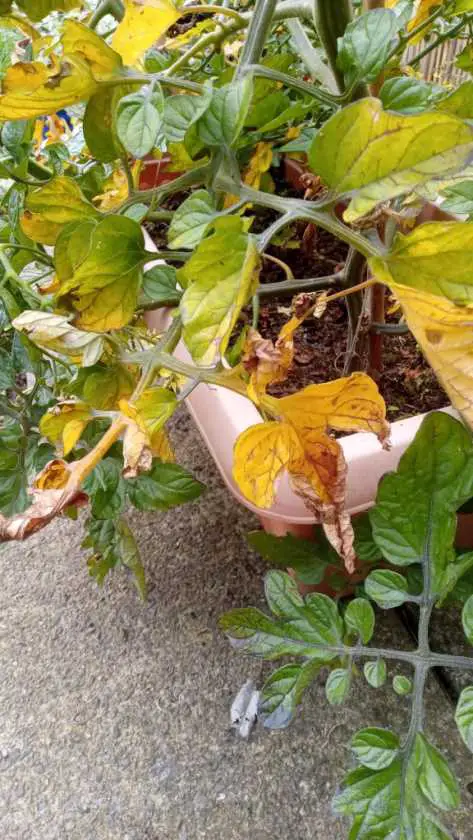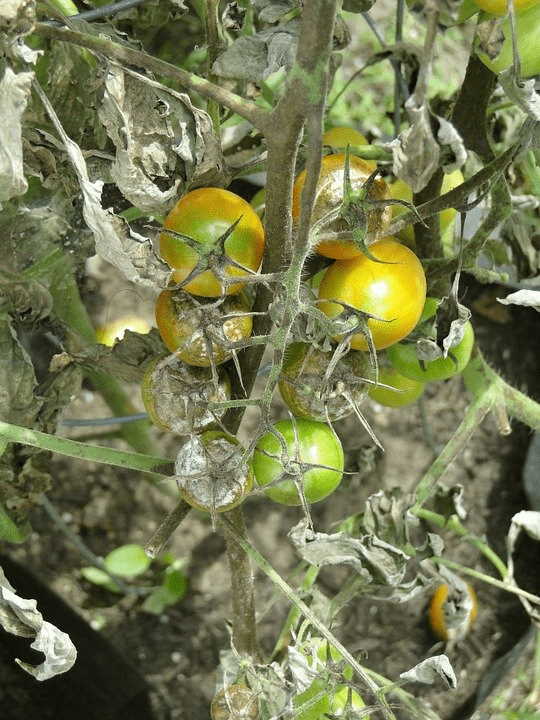We all love our plants, especially those that bring juicy, fresh vegetables to our table. Discovering your tomato plant leaves turning yellow can be a daunting sight. A few yellow leaves on the plant are natural and shouldn’t be a matter of concern, but too many of these should raise a red flag.
It’s commonly thought that yellow leaves on tomato plants are because of overwatering. This is sometimes the case but there could be many reasons behind yellowing leaves. Sometimes, the fix is as simple as adjusting the watering pattern. At other times, it’ll take a bit more work than that. Your first move should be to investigate the root cause. Each cause is addressed differently; however, keep your hopes up since, in most cases, your tomato plant can be rescued.
Reader Poll: What online courses would interest you?
Causes For Yellow Leaves On Tomato Plants
There are 4 main things to try when you find yellow leaves on your tomato plant. Yellow leaves isn’t a condition of something specific rather that the plant is generally unhealthy.
Lack Of Sunlight
Starting with the simplest of the issues, the leaves on your tomato plants could be turning yellow if they aren’t getting enough sunlight.
Fix: If you’ve planted it in a container, move it to a brighter spot to fix it.
Subscribe to our newsletter!
Sometimes, the lower leaves on a big bushy, fully mature tomato plant start turning yellow. That’s because their sunlight is being blocked by the leaves and fruits on the plant’s upper portions. As long as the plant is healthy and bearing fruit, this shouldn’t be a concern.
Inconsistent watering
Both overwatering and underwatering can result in yellowing leaves. Tomato plants are a bit fussy when it comes to soil moisture. They want just the right level of moisture to thrive. Be careful not to let the soil turn too dry or too wet. Water your tomato plant a few times per week, depending on the weather conditions and the soil type. Let the soil dry between waterings, water thoroughly, but not so much that it turns the soil soggy. Always water at the base of the plant, taking care not to soak the leaves.
Fix: If your tomato plant has already started showing yellow leaves, correcting the watering pattern will most likely reverse the problem.
Lack Of Nitrogen
Nitrogen is responsible for giving the leaves that fresh green colour that reflects healthy growth. Check your soil for its nitrogen level. Insufficient nitrogen is another reason for yellowing leaves. A soil test will easily tell you if you need to include more nitrogen or other nutrients in the soil through fertilization. Be careful not to add too much nitrogen, either. An excess of nitrogen makes the tomato plant bushier and greener but lowers its capacity to bear fruit.
Fix: Based on the soil test outcomes, choose a suitable fertilizer mix and feed it once a month throughout the growing season. Feed it more often (once a week) once it starts fruiting.

Fungal diseases
Certain fungal diseases in your tomato plant might also show the same symptoms. These include:
Early blight initially targets the oldest leaves at the lower end of the plant. It is evident by small brown spots that grow bigger with time and take the shape of a bull’s eye. The yellowing leaves will wither and ultimately die.
Fix: The fruit is usually unaffected, but it’s best to pinch out the damaged leaves before the disease spreads.

Late blight is a bit more problematic than early blight. It begins on the upper leaves, unlike early blight. It starts with the appearance of green or gray spots on the leaves. The spots darken with time, also affecting the stems. It will only take two weeks to kill the plant, so act fast!
Fix: Get a good quality fungicide and apply it to the plant as soon as you notice the early signs.
It’s a common problem that affects tomato plants globally. The fungus attacks the plant’s roots inhibiting its ability to absorb water. The plant will start wilting, it’s growth will be hampered, and also its ability to bear fruit.
Fix: It’s highly unlikely that the plant will recover from this disease. Before it spreads to other plants, uproot the infected plant and burn it or dump it. Treat the soil before planting something there.
This fungal infection is more common in tomato plants in cooler regions. It begins with yellow patches on the lower leaves, which ultimately turn brown, curl and die. Diagnose it by cutting off the infected stem and looking for any discoloration in the cross-section.
Fix: Don’t let the infection spread to other plants. It’s best to uproot the infected plant and burn it or dump it. Treat the soil before replanting.
It’s an infection caused by soil-borne bacteria and is typical to moist and sandy soils. Youngest leaves are the first ones to show signs of wilting. Eventually, more leaves will start yellowing and dying. Before long, the plant will die.
Fix: The infected plant can’t be saved. You can save the rest of the crop by uprooting the plant, discarding it, and treating the soil.
- Septoria Leaf Spot
As was the case with early blight, the lower leaves will start turning yellow. They’ll darken into gray or brown. Unlike for early blight, the spots are smaller, and more in number.
Fix: Use the same fix as mentioned for early blight.
- Pests

Pest attacks can also result in the yellowing on leaves. When pests, like aphids, thrips, and spider mites feed on the leaves, they transfer toxic saliva to the plant, which causes the leaves to turn yellow with visible purple veins.
Fix: Use insecticidal soap to treat smaller pests like spider mites and aphids. The larger pests like cutworms and hornworms can be picked off the plant by hand.
How To Treat Overwatered Tomato Plants
Though there can be other reasons why the leaves on your tomato plants are turning yellow, the most common culprit behind the problem is still overwatering. Here’s how to diagnose and save an overwatered tomato plant.
Symptoms of Overwatering
Overwatering is identified by signs shown by the plant itself, as well as by the looks of the soil surrounding the plant. Water-stressed plants will show cracked fruits and blistered leaves. In the initial stages of overwatering, the leaves will start wilting but stay green. Gardeners often take it as a sign that plants need more water.
When overwatering continues, the leaves will start turning yellow. This is a sign of oxygen and nutrient deprivation in plants which results from root rot. So yellowing leaves could mean that you’re dealing with a bad case of root rot. Water-logged conditions and slow-draining soils contribute to root rot.
Other than the looks of the plant, you can also tell if it’s being overwatered by looking at the soil around it and your watering pattern. If you water before the soil surface turns dry and the soil stays wet all the time, overwatering is causing damage to your tomato crop.
The Solution
The simplest solution is to correct the watering pattern. Allow the top 2 inches of the soil to dry out before watering the plant again. Water early morning to prevent evaporation and allow the soil to soak up the moisture nicely. With some luck, the tomato plant will gradually revive and start producing again.
Unfortunately, the above fix will only work if the plant is in its initial stages of water-stress. Heavily stressed plants are accompanied by root rot condition, and the fix isn’t so easy for that. At this stage, transplanting the plant may work and it may start to thrive. Dig out the plant from the ground or the pot. Gently remove the dirt stuck to the roots. Remove the decaying parts of the root, cutting slightly above the decay so that the problem does not resume. Place the root side of the plant over layers of newspapers to absorb excess moisture. Transplant it in a pot with fresh potting soil. Depending on how much of the healthy root is left and the growth of the plant, the tomato plant may or may not survive. Be prepared to start from scratch if the fix doesn’t work after all.
If an in-ground tomato plant is suffering from overwatering due to frequent rainfall, cover it with a plastic sheet to prevent some of the damage. Dig it up and transplant it in a pot once the rains stop.
Conclusion
These were the main reasons why the leaves of your tomato plant could be turning yellow. There could be other reasons, too, for the problem, such as excessive heat, or overuse of fertilizers.
Occasional yellowing and wilting of leaves are natural, so don’t overreact just yet! However, if they’re yellowing and wilting too fast or abnormally, refer to the guide above and fix it before it’s too late.

